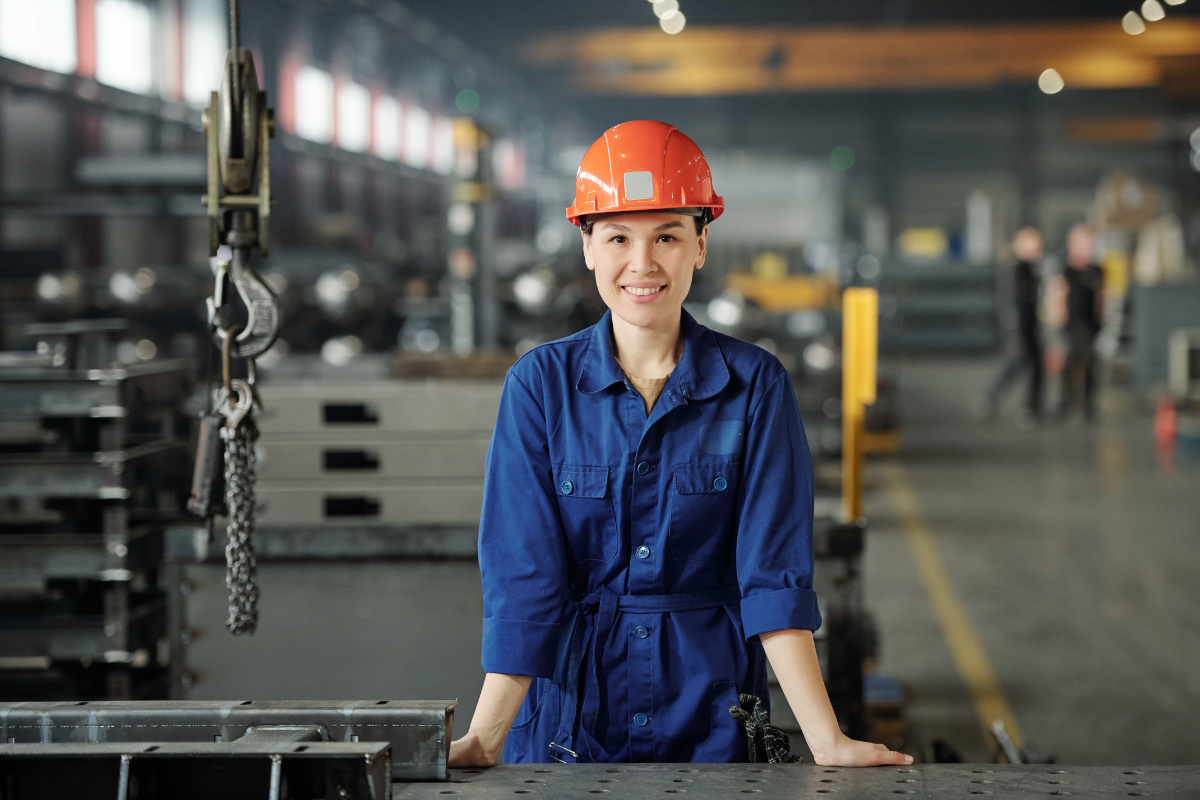Two forklifts align themselves at each end of a fully-loaded 30′ storage rack and slide their forks under. The idea is to “carefully” lift the rack and move it several feet. One forklift will drive forward while the second reverses at the same speed. Timing is critical.
The warehouse manager is on the scene to watch the successful movement of the rack. The forklift operators had never attempted such an undertaking before but are confident in their abilities. Can you guess how this will end?
If you answered “badly,” you’d be right.
This is just one out of thousands of examples. Of course, it went badly. They didn’t even get to the driving part of the process. One lifted his forks faster than the other. A 30′ tall rack that was loaded with pallets of machined airplane parts first gave a slight groan, then came a wrenching, tearing sound. The entire rack gave way, sending parts flying across the warehouse.
Thankfully no injuries were sustained. Imagine being the safety officer having to address the entire crew and management about just how terrible an idea this was.
A safe, hazard-free warehouse is paramount to the success of your business. Unfortunately, warehouse safety is often overlooked when it comes to big-picture planning. Adding a standard safety checklist to be followed can be a lifesaver in your warehouse facilities.
Warehouse injuries occur regularly, though focusing on safety helps lower the number of accidents. Slips and falls are far too common. These are injuries from improper lifting techniques, hazardous material mismanagement, and dangerous equipment.
By focusing on warehouse safety, the risk of injuries and lost work hours are reduced. Accidents involving equipment can also be avoided by implementing safety procedures and protocols.
Section 1. How does Singapore manage Workplace Safety?
The Ministry of Manpower
The Ministry of Manpower’s (MOM) Occupational Safety and Health Division operates a fleet of safety inspectors. The inspectors are responsible for ensuring warehouses are following safety protocols.
Over the last several years, incidents involving vehicles have been among the leading causes of fatal workplace injuries. The Ministry launched what they dubbed Operation Junco to target workplaces where vehicle accidents are more likely to occur.
Warehouses, construction sites, and more all fall under the heightened scrutiny of the new operation. Incidents of vehicular accidents and fatalities have been on the rise, which has prompted greater scrutiny of the warehousing sector.
According to a recent article, common occurrences at warehouses include leaving the keys in the ignition of forklifts, untrained and unlicensed workers operating forklifts, and worn, battered forklifts in serious need of repair. These occurrences are avoidable, though if detected during an inspection, it will result in a fine.
Singapore has regulations that require that a safety officer be appointed if the workplace meets specific requirements. Workplaces that deal with petroleum products at factories and shipyards, with over 100 employees, or deal with high-cost engineering are among those that fall into that requirement.
When the inspectors find safety concerns, they have the option to order a work stoppage. The stoppage’s breadth can be from one section of the warehouse to the entire company being put on hold. It depends on the severity of the safety violations.
One example is of a worker driving a forklift that is badly in need of repair. At the same time, the racks within the warehouse show apparent signs of damage. Pallets that have been used for far too long, structural issues with the racks due to collisions with forklifts, and other safety concerns were all captured by the inspectors.
A partial work stoppage was ordered on that specific warehouse section and would remain until repairs were made. Once complete, a safety inspector would return to the site to evaluate the repairs and remove the stop-work order.
There is always a level of frustration from the business when a work stoppage is ordered. Still, the inspection teams are well versed with how to deal with any of these issues. Working with the management teams and coming to an amicable solution is possible. However, the main focus of the inspectors is the safety of the workers and pedestrians.
One inspector mentioned that they thought the worst safety violation is not telling workers about any violations the company has received. Proper safety training is critical to avoid stop-work orders and maintain a safe work environment
The Ministry of Manpower oversees the inspection process for Singapore. They have easy-to-use websites that provide several different pieces of training, registrations, and how-to articles.
The MOM website has in-depth walkthroughs for earning workplace safety and health skill qualifications, or WSQ’s. These are used to keep your status current with the workplace safety and health requirements.
There are detailed records on performing safety-related trainings for those operating cranes, lifts, forklifts, and more lift systems. Following the guidelines laid out by MOM will improve the safety of the workplace.
With such a hands-on system in place, Singapore is again starting to lead the world in safe, affordable warehousing options. Having access to consistently train safety officers in any new and upcoming legislation keeps your crew up to date.
The information available regarding Workplace Safety and Health shows how Singapore places such a high importance on workplace safety. The content available also covers how to begin a venture with existing companies within Singapore that meet safety standards.
Section 2: 10 best practices for Warehouse Safety
Working in a warehouse with other people is always going to come with a certain level of risk. The real key is to ensure the entire group is trained on the best practices for warehouse safety.
Accidents happen, but with proper preparation, most can be avoided. When working in a warehouse, make sure to check out the surroundings before operating a vehicle or lift.
A worker was unloading a vehicle with a forklift. The worker tried to pick up far too much weight. When he backed across the flimsy ramp, it collapsed, dropping the forklift several feet and sending the product scattering across the loading dock and out into the road.
The driver was slightly injured, but nothing major. The real cost was damage to the forklift and loss of product. By using best practices for safety, accidents like this can be avoided.
From driving forklifts to maintaining pallets, it’s critical that the warehouse team is well rehearsed in safety practices. There are several common best practices that will keep your warehouse moving smoothly.
Reduction of risk is key to avoiding accidents and injuries. Let’s take a look at ten best practices to keep workers safe. After all, safe workers tend to stay at the company far longer than those that feel the job is unsafe.
The Ministry saw such an increase in injury rates that it put together an industry forum to implore businesses to raise awareness and implement safety protocols.
Always Use the Proper Safety Equipment
Safety equipment is critical to a well-maintained and safe warehouse. Workplace injuries can be minimized by keeping a safe environment.
A dependable sprinkler system will protect against fire, as will fire extinguishers. The extinguishers are useless if they can’t be accessed. Be sure that all emergency exits and sprinkler systems remain clear and unobstructed.
There are areas that may require safety boots, hard hats, and safety glasses. It’s a good practice to have different workers responsible for alerting workers if they are violating protocols. Rotating the workers through the role ensures the workers stay safe.
Use the proper equipment for heavy lifting. A two-person team should be used for any lifting over 50 – 75 lbs. If the item is too heavy for a team to lift, it’s time to use a forklift to get the item moved.
Proper Storage Techniques
Ensure that all employees are familiar with the proper ways to store products on racks. Never put heavier items on top shelves. Start with heaviest on the bottom, then lighter as you go up.
Overloading storage racks can cause them to collapse and can lead to serious injury and death.
Working at Heights
If a person can fall a far enough distance to become injured, that place is considered working at height. Proper precautions must be in place to protect against falls.
By design, workers are going to be tasked with storing and removing products at potentially unsafe heights. Equipment such as cherry pickers and other lift vehicles help reduce the risk. Still, only proper training, maintenance, and safety gear will keep employees safe.
The Ministry of Manpower (MOM) has found that work at height accidents are generally caused by using an unsafe platform. Platforms that have open sides are more likely to cause work from heights injuries.
Comprehensive risk assessments and providing the proper safety equipment are requirements for WSH management to provide to their employees.
Be sure to equip any work at height location with tie-offs and safety harnesses. Add a consistent, regular maintenance schedule on the platform as well.
Remove Any Safety Hazards From Warehouse Floors
Warehouse floors can become hazards very fast. Add one part smooth flooring and one part water or other liquid, and you’re bound to have a slip and fall. Electrical cords that aren’t properly marked off and covered can cause tripping incidents. Tripping in a warehouse can lead to serious injury.
A regularly scheduled maintenance plan complete with checklists for daily tasks will keep the warehouse safe. Check for any surface cracks, pitting, and other issues with the floor. They need to be fixed immediately.
Mark Designated Hazard Zones
Equipment and other hazardous materials need to be stored in areas that are marked as designated hazardous zones. The flooring within the warehouse should have clearly marked and labeled walkways.
Properly marking the walkways and hazardous areas will ensure worker safety. Overly complex walkway markings can also become problematic, as this business soon realized.
Upon installing the necessary racks and equipment in a new warehouse, the business went about making a color-coded walkway system throughout the place. They used several colors to indicate who would have the right-of-way while moving product and machinery.
This business worked with hazardous chemicals and marked the walkways to designate differing routes for different chemicals. Unfortunately, the colors began to run together after the floor got wet. Within two days of opening, there was a collision of lifts transporting extremely hazardous materials. Several workers were injured, and a few lost their lives.
The chemicals mixed and caused a fire, consuming the new warehouse in a matter of hours.
Make sure to clearly mark your walkways with simple, easy-to-follow designations.
Practice Safe Lifting
When loading and unloading materials, be sure to follow proper lifting guidelines. If the load requires multiple workers to move, execute a proper team lift. If too large for a team to move, use a lift of some type.
Forklifts and other material lift equipment need to be operated by properly trained and licensed employees. Never attempt to operate any machine without the proper training.
Be sure there is ample room to move the lift through the aisles of the warehouse. If the racks are too close together, the forklift may collide with one, causing a potential chain reaction. We’ve all seen these results play out on YouTube, and nobody wants to be the star of the next one to go viral.
Eliminate Fire Risks
Fires cause massive damage to warehouses. When setting up a warehouse, it is vital to plan a fire prevention system from the start. Keep in mind that the majority of warehouse fires are caused by overloaded electronic components. Sparks are not your friends.
Keep waste to a minimum within the warehouse, and be sure to store any flammable liquids in their own designated hazardous area. Due diligence and the inclusion of a fire prevention plan will help keep your warehouse safe.
Safety Training
Most successful warehouses require their workers to attend safety training on day one. Refresher courses are taught throughout the year to keep everyone up to date on any changes and to instill the importance of safety in the workplace.
Accidents happen when employees stop paying attention and start playing around or cut corners. If there isn’t safety training implemented at the business, it’s more likely employees will cut corners and eventually cause harm.
Include the damages that are caused by negligence and poor safety practices in the safety training. The staff will generally follow the safety guidelines closely if they are made aware of the adverse actions that can happen if they don’t.
Create a Vocal Workforce
Encourage the team to be aware of their surroundings at work. Set up universal alerts for moving machinery or items. Have rules like stopping at intersections within the warehouse and announcing their location. Being vocal and calling out to others will greatly reduce accidents and collisions.
Encourage the “If you see something, say something” approach. Workers need to be vocal about any possible hazards they encounter around the warehouse.
Encourage Active Participation
Warehouse employees are just like everyone else. They love incentives. By providing quarterly or annual safety incentives to your workers, you will find a greater focus on overall workplace safety.
The more your employees focus on safety, the less you have to worry about injuries, losing employees, and lost production. If giving out an incentive to your team can keep you from having to deal with that, you’ve done well.
Section 3. How does Modern Technology help with warehouse safety?
Technology keeps evolving. As it does, the ability to integrate it into the workforce is becoming easier and easier. From RFID solutions to the work that Amazon and Toyota have been creating, warehouses are becoming safer than ever before.
Vests that send a signal to the robots retrieving items within Amazon warehouses ensure that workers don’t get run over by the robots. Smart inventory features make taking a daily inventory no more of a task than sending a few workers out with RFID scanners to go through the entire warehouse in minutes instead of hours.
By fusing modern technology with warehouse safety, moving around a warehouse is becoming safer than ever before.
Toyota created the SpotMe system to keep workers safe while being able to move products throughout the warehouse efficiently.
Bridging next-level technology with ingenuity has allowed huge steps in warehouse automation and improvements.
Warehouse safety is everyone’s job
A trend in todays’ warehouse industry is the Warehouse Safety Officer. This position is tasked with the safety training of all employees and implementing any new safety procedures to keep workers safe.
The best practices of a Warehouse Officer are to focus on the daily safety and health of the employees and not treat safety requirements as a regulatory burden. A safe workforce is a productive workforce.
If everyone understands that safety is part of their job and takes it seriously, the business can flourish. A company that stands behind its employees in implementing safety procedures will attract better talent.
Employees can make a huge difference to the company by reducing risks and lowering accident rates. Workers aren’t going to miss as much work because they will feel safe and appreciated by their employer.
Happy, healthy employees lead to a better reputation for the company. A company with a solid reputation for corporate responsibility will bring more investors, which will, in turn, grow the company.
Safety is a key driver to a successful business. Lower turnover, fewer injuries and accidents, fewer legal issues, and happier, more motivated workers are all reasons why safety should be your focus.
[cp_popup display=”inline” style_id=”576″ step_id = “1”][/cp_popup]

Rent Lease Buy Sell
Rent Lease your next Factory Manufacturing Space in Singapore!
Lorem ipsum dolor sit amet, consectetur adipiscing elit. Ut elit tellus, luctus nec ullamcorper mattis, pulvinar dapibus leo. Welcome to Singapore 15 Surprising Ways New …
Read More →

Grow Your Business in Singapore
How Urban Redevelopment Authority (URA) Helps you Grow Your Business in Singapore
In this article, you learn how URA will help your business grow. We’ll cover the following critical issues:
* URA Oversees Development in Singapore, and What You Can Do with Your Property
* Changing the Use of Your Property
* URA’s Business Opportunities for Industrial and Commercial Enterprises
* URA Handbooks with Crucial Guidelines
Read More →
Grow Your Business in Singapore
How EDB Singapore helps you grow your business
Read More →
Warehousing in Singapore
Introduction to Warehouse Safety in Singapore
Two forklifts align themselves at each end of a fully-loaded 30′ storage rack and slide their forks under. The idea is to “carefully” lift the …
Read More →

Grow Your Business in Singapore
How Urban Redevelopment Authority (URA) Helps you Grow Your Business in Singapore
In this article, you learn how URA will help your business grow. We’ll cover the following critical issues:
* URA Oversees Development in Singapore, and What You Can Do with Your Property
* Changing the Use of Your Property
* URA’s Business Opportunities for Industrial and Commercial Enterprises
* URA Handbooks with Crucial Guidelines
Read More →

Welcome to Singapore
14 Reasons Singapore is excellent for Australians to Grow a Business
Singapore Welcomes Australia: As one of the world’s competitive economies, the Singapore ‘Lion City’ makes it easy for Australians to set up a business. You benefit from high quality workforce, and robust financial and technical Infrastructure.
Read More →
[astra_custom_layout id=2273]
